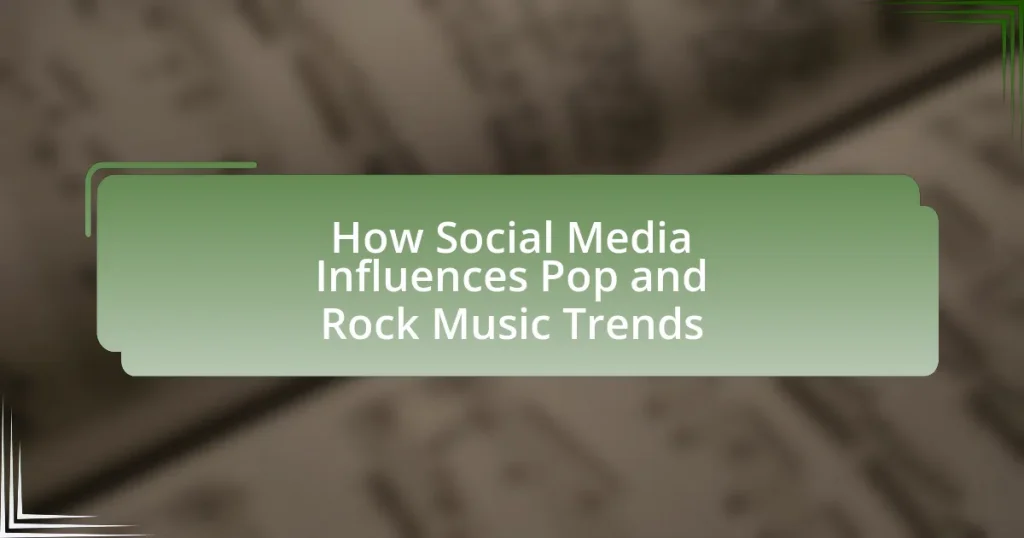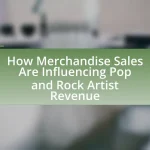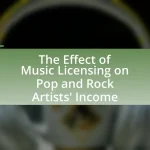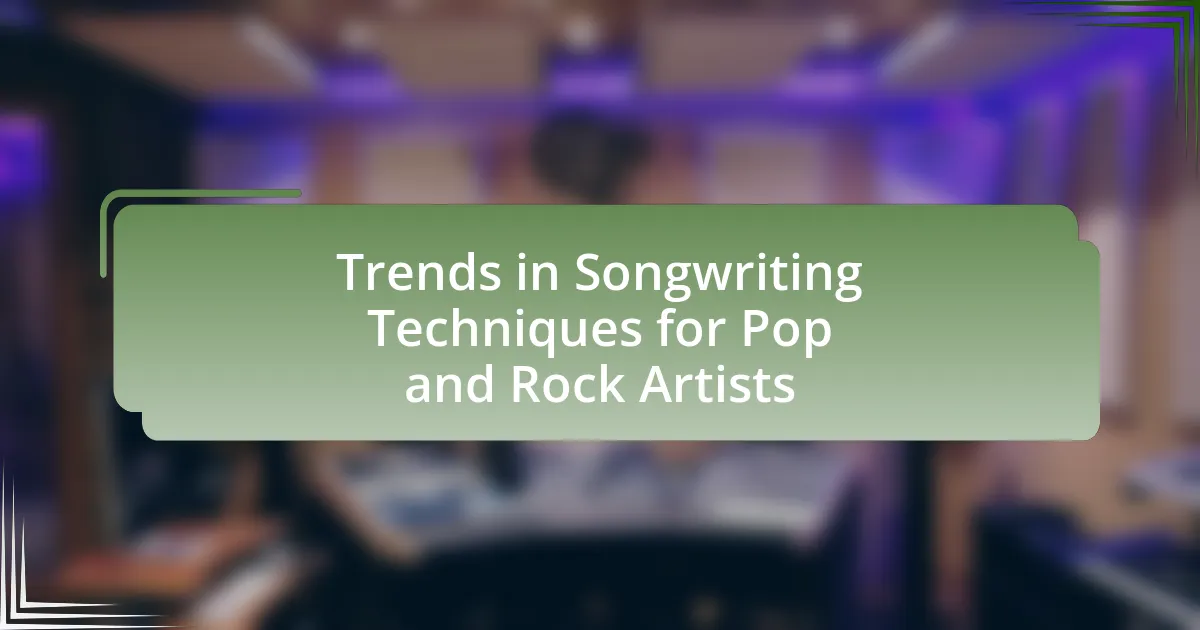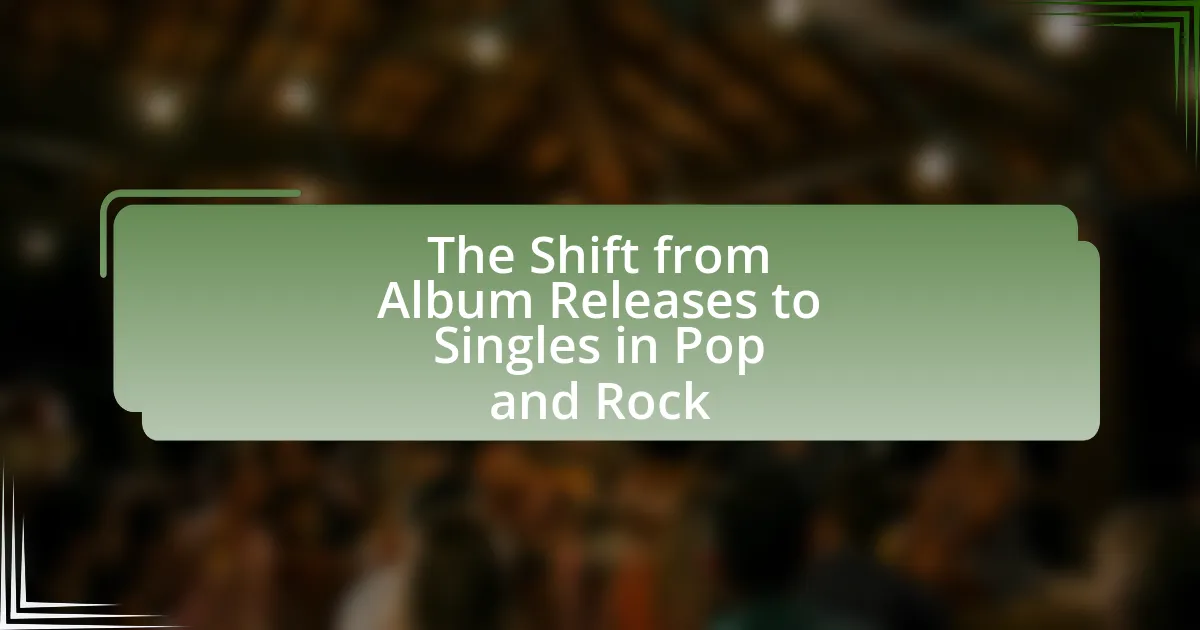The article examines the significant influence of social media on pop and rock music trends, highlighting how platforms like TikTok and Instagram facilitate rapid music dissemination and direct artist-fan interactions. It discusses the role of social media in shaping music genres, enhancing music discovery, and driving viral trends that can propel songs to mainstream success. Additionally, the article explores the challenges and opportunities presented by social media for artists, including the impact of fan engagement, influencer marketing, and the changing landscape of music consumption. Key metrics for measuring success on social media platforms are also outlined, emphasizing the importance of effective engagement strategies for artists in the contemporary music industry.
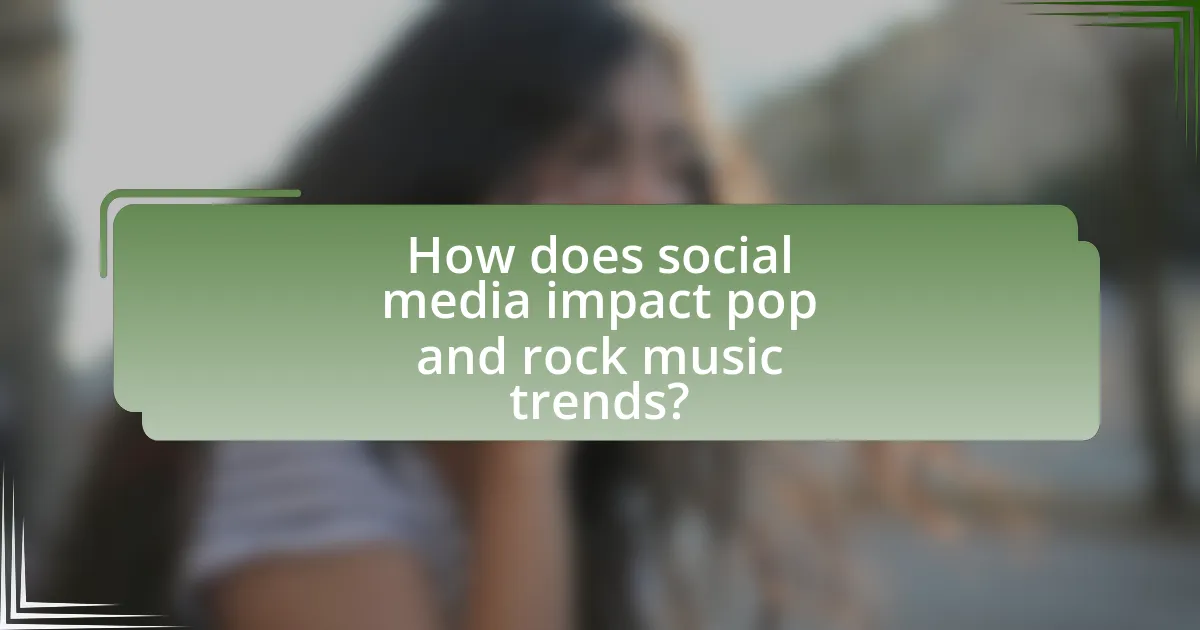
How does social media impact pop and rock music trends?
Social media significantly impacts pop and rock music trends by facilitating rapid dissemination of music and enabling direct artist-fan interactions. Platforms like TikTok and Instagram allow artists to share snippets of their work, leading to viral trends that can propel songs to the top of charts. For instance, the song “Old Town Road” by Lil Nas X gained immense popularity through TikTok, demonstrating how social media can create overnight sensations. Additionally, social media analytics provide artists and labels with real-time feedback on audience preferences, influencing the direction of future music production. This dynamic interaction between artists and fans shapes the evolution of music trends in both genres.
What role does social media play in shaping music genres?
Social media plays a crucial role in shaping music genres by facilitating the rapid dissemination of new sounds and trends among diverse audiences. Platforms like TikTok, Instagram, and YouTube allow artists to share their music directly with listeners, bypassing traditional gatekeepers such as record labels and radio stations. This direct access enables emerging genres to gain traction quickly; for instance, the rise of genres like lo-fi hip hop and bedroom pop can be attributed to viral trends on these platforms. Additionally, social media algorithms promote content based on user engagement, which can amplify niche genres and create new subcultures within the music scene. The influence of social media is evident in the way artists collaborate across genres, leading to hybrid styles that reflect a broader range of influences and tastes.
How do platforms like Instagram and TikTok influence music discovery?
Platforms like Instagram and TikTok significantly influence music discovery by enabling artists to share their work directly with audiences and facilitating viral trends. These platforms utilize algorithms that promote content based on user engagement, allowing songs to gain rapid popularity through challenges, dance routines, and user-generated content. For instance, a study by the University of Southern California found that songs featured in TikTok videos can see a 1,000% increase in streams on platforms like Spotify shortly after their viral moment. This direct connection between social media engagement and music consumption illustrates how these platforms reshape the landscape of music discovery.
What are the effects of viral trends on music popularity?
Viral trends significantly enhance music popularity by rapidly increasing exposure and engagement with songs. When a song becomes associated with a viral challenge or meme on platforms like TikTok, it can lead to a surge in streams and downloads, as evidenced by the success of tracks like “Old Town Road” by Lil Nas X, which gained immense popularity through viral social media usage. This phenomenon is supported by data showing that songs featured in viral trends often see a spike in chart rankings, with Billboard reporting that TikTok-driven tracks frequently dominate the Hot 100.
Why is social media essential for artists in the music industry?
Social media is essential for artists in the music industry because it provides a direct platform for engagement with fans and promotes their music effectively. Artists can share their work, receive immediate feedback, and build a loyal fanbase without relying solely on traditional media channels. According to a 2021 report by the International Federation of the Phonographic Industry, 70% of music consumers discover new music through social media platforms, highlighting its critical role in music promotion and audience reach. Additionally, social media allows artists to showcase their personalities and connect on a personal level, which can enhance fan loyalty and increase streaming numbers.
How do musicians use social media for promotion?
Musicians use social media for promotion by engaging directly with their audience, sharing content, and building their brand. Platforms like Instagram, Twitter, and TikTok allow artists to post updates, share behind-the-scenes footage, and interact with fans in real-time, fostering a sense of community. For instance, a study by the University of Southern California found that 70% of musicians reported increased fan engagement through social media, which directly correlates with higher streaming numbers and ticket sales. Additionally, musicians often utilize targeted advertising on these platforms to reach specific demographics, enhancing their promotional efforts.
What are the benefits of direct artist-fan engagement on social media?
Direct artist-fan engagement on social media enhances loyalty, increases visibility, and fosters community. This engagement allows artists to build a personal connection with their fans, which can lead to increased fan loyalty; studies show that 70% of fans feel more connected to artists who interact with them online. Additionally, social media platforms provide artists with a direct channel to promote their work, leading to greater visibility and potential sales. Engaging with fans also creates a sense of community, as fans share experiences and content, further amplifying the artist’s reach.
How has social media changed the way music is consumed?
Social media has fundamentally transformed music consumption by enabling instant access to a vast array of music and facilitating direct artist-fan interactions. Platforms like Spotify, YouTube, and TikTok allow users to discover, share, and stream music effortlessly, leading to a shift from traditional album sales to streaming models. According to the Recording Industry Association of America (RIAA), streaming accounted for 83% of the U.S. music industry’s revenue in 2020, highlighting the dominance of this consumption method. Additionally, social media platforms serve as promotional tools, where viral trends can propel songs to popularity, as seen with TikTok’s influence on tracks like “Old Town Road” by Lil Nas X, which gained massive traction through user-generated content.
What are the differences in music consumption patterns before and after social media?
Music consumption patterns before social media primarily involved traditional media channels such as radio, television, and physical sales, while after the rise of social media, streaming platforms and social sharing became dominant. Before social media, listeners relied on curated playlists from radio stations and music videos on TV, leading to a more passive consumption experience. In contrast, after social media emerged, platforms like Spotify, YouTube, and TikTok enabled active engagement, allowing users to discover, share, and promote music directly, significantly increasing access to diverse genres and independent artists. This shift is evidenced by the rise of streaming services, which accounted for 83% of the U.S. music industry’s revenue in 2020, compared to just 15% from physical sales in 2010, highlighting the transformative impact of social media on music consumption.
How do streaming services integrate with social media platforms?
Streaming services integrate with social media platforms by enabling users to share content, create playlists, and engage with their favorite artists directly through social media channels. For instance, platforms like Spotify allow users to share songs and playlists on Facebook and Twitter, enhancing visibility and engagement. This integration fosters community interaction and promotes music discovery, as users can see what their friends are listening to, which influences their own music choices. Additionally, streaming services often utilize social media for marketing campaigns, leveraging user-generated content and influencer partnerships to reach wider audiences, thereby driving user engagement and subscription growth.
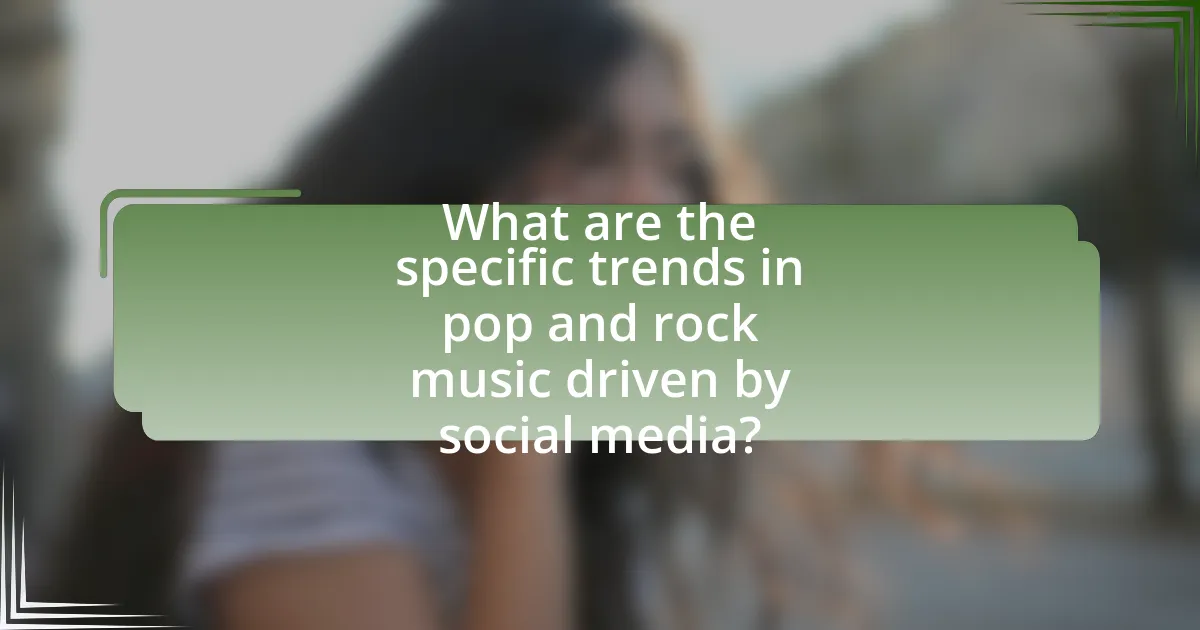
What are the specific trends in pop and rock music driven by social media?
Social media has significantly influenced pop and rock music trends by facilitating viral challenges, promoting direct artist-fan engagement, and enabling the rapid spread of new music. Viral challenges, such as those on TikTok, have propelled songs like “Old Town Road” by Lil Nas X to mainstream success, demonstrating how platforms can create overnight hits. Additionally, artists utilize social media to connect with fans, share behind-the-scenes content, and receive immediate feedback, which shapes their music and marketing strategies. The rapid dissemination of music through platforms like Spotify and YouTube has also altered traditional release cycles, allowing for more frequent single releases rather than full albums. These trends highlight the transformative role of social media in shaping the contemporary music landscape.
How do social media challenges influence music releases?
Social media challenges significantly influence music releases by creating viral trends that can propel songs to mainstream success. For instance, platforms like TikTok have enabled songs to gain popularity through user-generated content, where challenges often involve specific dance routines or themes associated with the music. A notable example is the song “Savage” by Megan Thee Stallion, which saw a surge in streams and chart performance after a dance challenge went viral on TikTok, leading to its eventual topping of the Billboard Hot 100. This demonstrates how social media challenges can directly impact the visibility and commercial success of music releases, as artists leverage these platforms to engage audiences and promote their work effectively.
What types of challenges have gained popularity in recent years?
In recent years, viral challenges on social media platforms have gained significant popularity, particularly those involving dance routines, lip-syncing, and creative transformations. For instance, the “Savage Love” dance challenge and the “Renegade” dance challenge became widely recognized, with millions of users participating and sharing their versions on platforms like TikTok. These challenges often lead to increased visibility for songs and artists, as seen with the rise of tracks like “Say So” by Doja Cat, which gained traction through user-generated content. The engagement generated by these challenges not only boosts song streams but also influences music trends, showcasing the powerful role social media plays in shaping pop and rock music culture.
How do these challenges affect the success of songs?
Challenges such as oversaturation of content and algorithmic biases significantly hinder the success of songs. Oversaturation leads to increased competition, making it difficult for individual songs to gain visibility, as listeners are bombarded with numerous options daily. For instance, a study by the International Federation of the Phonographic Industry (IFPI) in 2021 indicated that 40% of music listeners feel overwhelmed by the sheer volume of new releases, which can dilute the impact of any single song. Additionally, algorithmic biases on platforms like Spotify and YouTube can favor established artists or specific genres, limiting exposure for emerging talents. This bias can result in a lack of diversity in popular music, as highlighted by research from the University of Southern California, which found that playlists often reflect a narrow range of musical styles, further constraining the success of songs outside these parameters.
What impact do social media influencers have on music trends?
Social media influencers significantly shape music trends by amplifying exposure and engagement for specific songs and artists. Their large followings allow them to introduce new music to diverse audiences, often leading to viral trends. For instance, platforms like TikTok have seen songs gain immense popularity through challenges and user-generated content, with tracks like “Old Town Road” by Lil Nas X achieving chart-topping success largely due to influencer promotion. This phenomenon illustrates how influencers can drive streaming numbers and chart performance, demonstrating their powerful role in the contemporary music landscape.
How do influencers choose which songs to promote?
Influencers choose which songs to promote based on audience engagement, personal taste, and current trends. They analyze metrics such as streaming numbers, social media buzz, and the song’s alignment with their brand identity. For instance, influencers often select songs that resonate with their followers’ preferences, ensuring higher engagement rates. Additionally, they may consider collaborations with artists who have a strong online presence or songs that are trending on platforms like TikTok, where viral challenges can significantly boost a song’s popularity. This strategic selection process is supported by data showing that songs promoted by influencers often see a marked increase in streams and social media mentions, validating the effectiveness of their choices.
What is the relationship between influencer marketing and music sales?
Influencer marketing significantly boosts music sales by leveraging the reach and credibility of social media personalities to promote artists and their songs. When influencers share music content, they can create viral trends, leading to increased streaming numbers and sales. For instance, a study by the Digital Marketing Institute found that 49% of consumers depend on influencer recommendations, which directly correlates with higher music consumption rates. Additionally, platforms like TikTok have demonstrated that songs featured in viral challenges can see a dramatic increase in sales, exemplifying the direct impact of influencer marketing on music sales.
How do fan interactions on social media shape music trends?
Fan interactions on social media significantly shape music trends by facilitating real-time feedback and engagement between artists and their audiences. This dynamic allows fans to express their preferences, share content, and create viral moments that can propel specific songs or genres into mainstream popularity. For instance, platforms like TikTok have been instrumental in launching tracks to chart-topping status, as seen with Lil Nas X’s “Old Town Road,” which gained traction through user-generated content and challenges. Additionally, social media analytics provide artists and labels with insights into listener demographics and preferences, enabling them to tailor their marketing strategies and music releases accordingly. This reciprocal relationship between fans and artists not only influences the types of music that gain traction but also shapes the overall sound and direction of the industry.
What role do fan-created content play in promoting songs?
Fan-created content plays a significant role in promoting songs by enhancing visibility and engagement through organic sharing and community involvement. This type of content, such as fan art, covers, and social media challenges, often generates buzz around a song, leading to increased streaming and sales. For instance, a study by the University of Southern California found that songs associated with user-generated content on platforms like TikTok experienced a 150% increase in streams compared to those without such content. This demonstrates that fan-created contributions not only amplify a song’s reach but also foster a deeper connection between artists and their audiences, ultimately driving commercial success.
How do artists respond to fan feedback on social media?
Artists respond to fan feedback on social media by actively engaging with their audience through comments, likes, and shares. This interaction often includes acknowledging positive feedback, addressing concerns, and sometimes incorporating fan suggestions into their work. For instance, a study by the University of Southern California found that artists who interact with fans on platforms like Twitter and Instagram tend to build stronger fan loyalty and increase their overall engagement metrics. This demonstrates that artists recognize the value of fan input and utilize social media as a tool to foster community and enhance their creative processes.
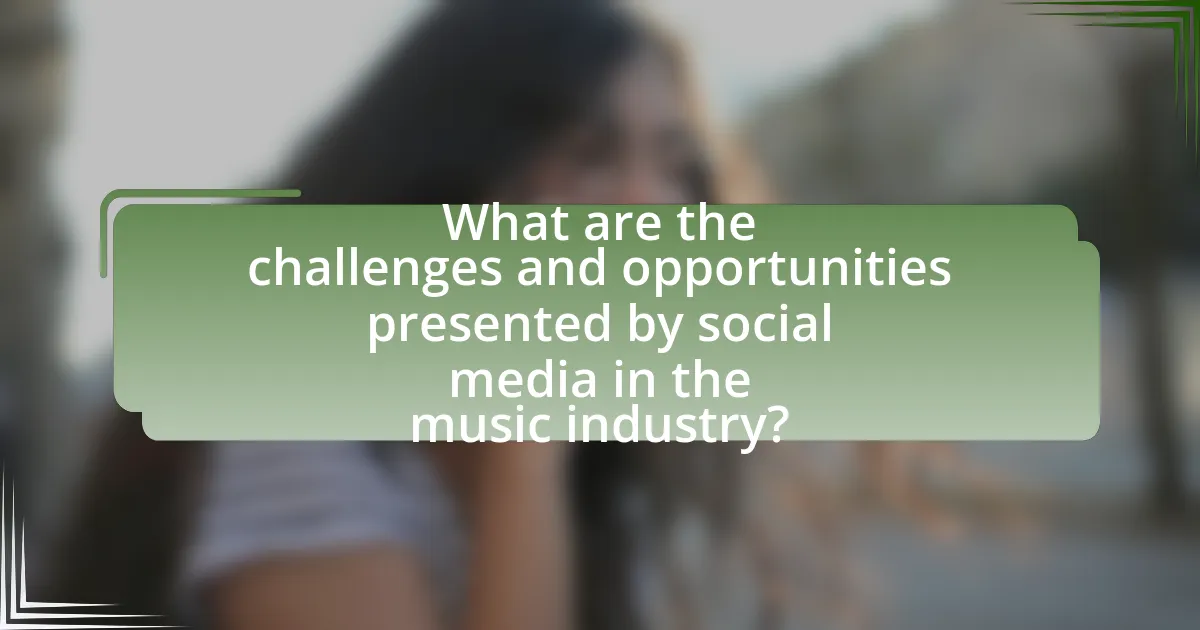
What are the challenges and opportunities presented by social media in the music industry?
Social media presents both challenges and opportunities in the music industry. One significant challenge is the oversaturation of content, which makes it difficult for artists to stand out; for instance, over 40 million songs are available on platforms like Spotify, leading to fierce competition for listener attention. Conversely, social media offers unprecedented opportunities for direct engagement with fans, allowing artists to build a loyal following and promote their music without traditional gatekeepers. For example, platforms like TikTok have propelled songs to viral status, as seen with Lil Nas X’s “Old Town Road,” which gained popularity through user-generated content. Thus, while social media complicates visibility for artists, it simultaneously empowers them to reach audiences directly and creatively.
What challenges do artists face when using social media?
Artists face several challenges when using social media, including oversaturation, algorithm changes, and mental health impacts. The oversaturation of content makes it difficult for individual artists to stand out, as millions of posts compete for attention daily. Additionally, frequent changes in social media algorithms can hinder an artist’s ability to reach their audience, as visibility often depends on paid promotions rather than organic engagement. Furthermore, the pressure to maintain a constant online presence can lead to mental health issues, such as anxiety and burnout, affecting an artist’s creativity and overall well-being. These challenges highlight the complexities artists navigate in leveraging social media for their careers.
How do negative comments or backlash affect artists?
Negative comments or backlash can significantly impact artists by affecting their mental health, public perception, and career trajectory. Artists often experience increased anxiety, depression, and stress due to negative feedback, which can hinder their creative process and overall well-being. For instance, a study published in the Journal of Social and Clinical Psychology found that social media criticism can lead to decreased self-esteem and increased feelings of isolation among artists. Furthermore, backlash can alter how audiences perceive an artist’s work, potentially leading to decreased sales and attendance at performances. This phenomenon is evident in cases where artists have faced public outrage, resulting in a decline in their popularity and marketability.
What are the risks of overexposure on social media?
Overexposure on social media can lead to several significant risks, including mental health issues, privacy concerns, and reputational damage. Mental health issues arise from constant comparison and validation-seeking behavior, which can result in anxiety and depression; studies indicate that individuals who spend more than two hours daily on social media are more likely to report poor mental health outcomes. Privacy concerns stem from sharing excessive personal information, making individuals vulnerable to cyberbullying, identity theft, and data breaches. Reputational damage occurs when oversharing leads to negative perceptions or backlash, as seen in cases where public figures faced career setbacks due to controversial posts. These risks highlight the importance of managing social media presence carefully.
What opportunities does social media provide for emerging artists?
Social media provides emerging artists with significant opportunities for exposure, audience engagement, and networking. Platforms like Instagram, TikTok, and YouTube allow artists to showcase their work to a global audience, bypassing traditional gatekeepers such as record labels. For instance, TikTok has been instrumental in launching songs to viral status, with tracks like “Old Town Road” by Lil Nas X gaining immense popularity through user-generated content. Additionally, social media facilitates direct interaction with fans, enabling artists to build a loyal following and receive immediate feedback. This direct engagement can lead to increased sales and concert attendance, as artists can promote their music and events directly to their audience. Furthermore, social media serves as a networking tool, connecting emerging artists with industry professionals, collaborators, and other artists, which can lead to new opportunities and partnerships.
How can new artists leverage social media for exposure?
New artists can leverage social media for exposure by creating engaging content that showcases their music and personality, utilizing platforms like Instagram, TikTok, and YouTube to reach wider audiences. These platforms allow artists to share snippets of their work, behind-the-scenes footage, and interact directly with fans, fostering a community around their music. According to a 2021 report by the International Federation of the Phonographic Industry, 70% of music consumers discover new artists through social media, highlighting its effectiveness as a promotional tool. By consistently posting and engaging with followers, new artists can build a loyal fan base and increase their visibility in the competitive music industry.
What strategies can artists use to build a loyal fanbase online?
Artists can build a loyal fanbase online by engaging consistently with their audience through social media platforms. Regular interaction, such as responding to comments and messages, fosters a sense of community and connection. Additionally, artists can share exclusive content, such as behind-the-scenes footage or early access to new music, which incentivizes fans to stay engaged.
Research indicates that artists who utilize platforms like Instagram and TikTok effectively can increase their visibility and reach, as these platforms prioritize authentic engagement. For instance, a study by the University of Southern California found that artists who actively engage with their followers can see a 30% increase in fan loyalty. By leveraging these strategies, artists can cultivate a dedicated fanbase that supports their work over time.
What best practices should artists follow on social media?
Artists should engage consistently with their audience on social media to build a loyal fan base. Regular posting, responding to comments, and sharing behind-the-scenes content fosters a sense of community and connection. According to a study by the Pew Research Center, 69% of adults in the U.S. use social media, highlighting its importance as a platform for artists to reach and interact with fans. Additionally, utilizing analytics tools to track engagement metrics allows artists to refine their strategies and understand what content resonates most with their audience. This data-driven approach enhances visibility and can lead to increased streaming and sales, as evidenced by the rise of artists who effectively leverage social media for promotion.
How can artists effectively engage with their audience on social media?
Artists can effectively engage with their audience on social media by consistently sharing authentic content and interacting directly with fans. This approach fosters a sense of community and connection, which is crucial for audience retention and growth. Research indicates that 70% of consumers feel more connected to brands when the brand’s CEO is active on social media, highlighting the importance of personal engagement. Additionally, utilizing features like live streams, Q&A sessions, and polls can enhance interaction, as these tools encourage real-time communication and feedback. Engaging with user-generated content also strengthens relationships, as it shows appreciation for fans’ contributions and builds loyalty.
What are the key metrics to track for success on social media platforms?
The key metrics to track for success on social media platforms include engagement rate, reach, impressions, follower growth, and conversion rate. Engagement rate measures the level of interaction (likes, comments, shares) relative to the audience size, indicating how well content resonates with users. Reach refers to the total number of unique users who see a post, while impressions count the total views, showing visibility. Follower growth tracks the increase in audience size over time, reflecting brand popularity. Conversion rate measures the percentage of users who take a desired action, such as clicking a link or making a purchase, demonstrating the effectiveness of social media efforts. These metrics collectively provide insights into audience behavior and content performance, essential for optimizing social media strategies.
